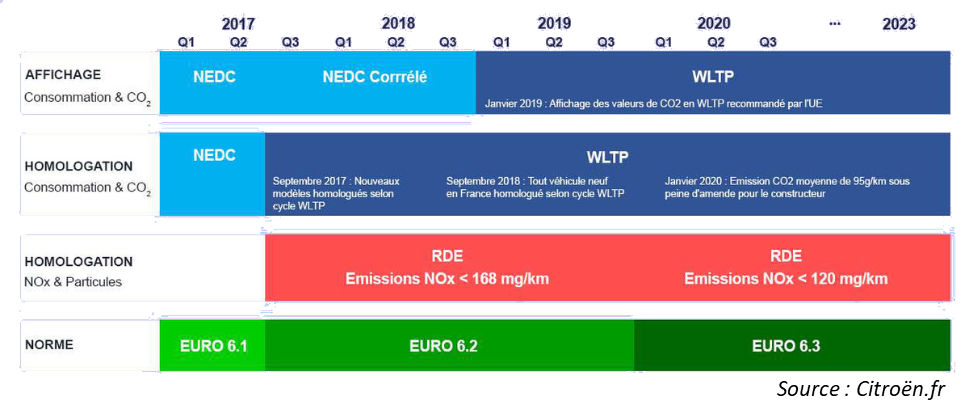WLPT : a predictable increase in taxation from 01/01/2020
Almost everyone now knows the acronym WLTP (World harmonized Test Procedures) Light- duty concerning the evolution of the rolling cycle and the evolution of test procedures.
WLTP supersedes the NEDC standard. The transition between its two standards (from 01/09/2018 to 31/12/2019) takes place under the name NEDC² or NEDC correlated.
WLTP has for objective :
- To determine the fuel consumption of a vehicle but also its CO² emissions
- To reduce the difference between the CO² values determined on the test bench and the actual consumption values.
The direct consequence of this new standard is the 20 to 30% increase in certified CO² emissions.
To reduce this increase, manufacturers will, among other things, try to limit the weight of the vehicle, increase its aerodynamics, and equip them with low rolling resistance tires.
And the fuel in all this? The 3 changes that must be remembered:
- With WLTP, fuel consumption increases by 1.3L/100kms (versus NEDC)
- With WLTP, the fuel consumption gap between gasoline and diesel will tend to narrow due to engine optimization since 2017. As a reminder with the NEDC standard the average fuel/diesel consumption difference is 1.5l/100kms.
- Since the beginning of 2019 the convergence of gasoline-diesel fuel prices and the recovery of 40% of the VAT on gasoline limit the difference of purchase cost between gasoline and diesel.
RDE : Inclusion of the pollution of fine particulate matters emissions and NOx
WLTP will be supplemented by the RDE (Real Driving Emissions) regulation concerning pollutant emissions (NOx and fine particulate matters). These are tests in real driving conditions made thanks to a mobile laboratory connected to the vehicle exhaust.
We will be able to:
- Measuring CO² emissions (impact on the planet)
- Measuring NOx emissions + fine particulate matter (health impact)
Compliance with pollutant thresholds will therefore be guaranteed.
These WFA regulations will be implemented after 2020.
Please note that Euro 6 diesel vehicles (standard in force since 2015) emit less NOx than the legal threshold that will come into force in January 2020, which is not yet the case for petrol vehicles.
Implementation of a very restrictive regulation for manufacturers from 2020 : CAFE
At the same time, the CAFE (Corporate Average Fuel Economy) regulation will impose an average CO² emission threshold on manufacturers not to exceed. Effective on 2020 sales, it will be able to, from 2021, cost hundreds of millions of euros of fines to manufacturers that have not mastered the maximum weighted CO² emission rate of vehicle sales.
The Volkswagen, PSA, FCA and Ford groups are at risk. Lower diesel combined with wholesale SUV could have a 20% impact on the profits of these manufacturers. Priority for small vehicles (city cars, 55% compact 27%) which now represent +80% of the French market (and constantly increasing) becomes a major issue for these manufacturers. More sober models in step with the pressure on the CO² drop become the answer.
To avoid these heavy fines, manufacturers will have to :
- Set up a European monitoring of their sales according to CO² releases in order to adapt the marketing of vehicles.
- Develop sales of electric vehicles and plug-in hybrids.
- Adapt vehicle prices to their CO²emissions
What impact from now on the market ?
Vehicle offerings are no longer sustainable, it is difficult to set up vehicle catalogues for a duration of more than three months. The attraction for petrol vehicles does not meet, for the moment, the offer of manufacturers who have difficulty to offer a complete and varied offer (motor).
The new environmental constraints are driving up the price of vehicles, and the tax burden is also contributing to the increase in the TCO.
The obligation of manufacturers to contain and limit CO² emissions from vehicles sold will limit the power and weight of vehicles on the one hand and significantly increase the price of large vehicles (SUV, Minivan). The market may eventually turn to sedans and breaks, lighter vehicles.
Finally the arrival of new energies (electric with battery or hydrogen) will force companies to finance themselves the infrastructures of charging of their vehicles.
The Government has certainly an ambitious programme which, from 2023, aims to establish 100,000 public charging points in the territory (in particular through a reform of the benefit in kind in order to facilitate recharging in companies), 100 hydrogen stations, 770 CNG stations.
The time will come when companies will have to choose between limiting their fleet in order to contain costs or accepting an explosion of their TCOs.




